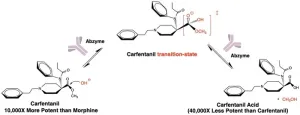(Press-News.org) Spiders that don’t weave good silk don’t get to eat. The silk spiders produce which creates their webs is key to their survival – but spiders live in many different places which require webs fine-tuned for local success. Scientists studied the glue that makes orb weaver spiders’ webs sticky to understand how its material properties vary in different conditions.
“Discovering the sticky protein components of biological glues opens the doors to determining how material properties evolve,” said Dr Nadia Ayoub of Washington and Lee University, co-corresponding author of the study published in Frontiers in Ecology and Evolution. “Spider silk fibers and glues represent a fantastic model for answering such questions since they are primarily made of proteins and proteins are encoded by genes.”
“Spider silks and glues have huge biomimetic potential,” added Dr Brent Opell of Virginia Tech, co-corresponding author. “Spiders make glues with impressive properties that would have applications in industry, medicine, and beyond.”
Tangled up in spider webs
Each strand of an orb weaver spider’s web contributes to the capture of food. The web has a stiff frame which absorbs the impact of prey, which are then trapped by sticky lines until the spider can tackle them. These lines are made sticky by an aqueous glue synthesized in aggregate glands. The glue absorbs water from the atmosphere and needs to be optimized to achieve the best stickiness results for the local humidity. But there are many species of orb weaver spider living in different environments, which means their glue must adapt to different levels of humidity.
To understand how spider glue stickiness adapts, Ayoub and her colleagues focused on two species, Argiope argentata — which lives in dry environments — and Argiope trifasciata, which lives in humid environments. The team collected webs from A. trifasciata in the wild and had A. argentata spiders build webs in the lab. To ensure that these webs were equivalent to webs in the wild, the scientists fed the spiders a diet comparable to their usual prey and compared glue droplet volume to wild controls to make sure that the humidity in the lab wasn’t affecting the droplets’ properties. They then analyzed the proteins in the glue and the droplets’ material properties.
A sticky situation
The team found that droplets from A. argentata spiders are smaller than those from A. trifasciata and absorb less water as local humidity increases. They also had smaller protein cores, occupying a smaller proportion of the droplet’s volume, and absorbed less water from the atmosphere. The toughness of glue droplets for both species of spider is based on the stiffness of the protein core of the droplets, and A. argentata protein core toughness decreased as the humidity went up. A. argentata thread glue droplets were generally more closely spaced and stickier.
The scientists also analyzed the proteins found in the glue droplets to understand how these differences in material properties arise from the proteins. Although the proteins they found were similar, they appeared in different proportions, and A. argentata glue contained the protein products of four genes which didn’t appear in A. trifasciata glue. These extra proteins and a more balanced ratio of AgSp1 and AgSp2 proteins may explain both the greater toughness of this glue and its lower capacity for water absorption.
“Despite the dramatic differences in material properties, the two species share most of their protein components,” said Opell. “The sequences of these proteins are also similar between species, but the relative abundance of individual proteins differs. Modifying the ratios of proteins is likely a rapid mechanism to adjust material properties of biological glues.”
“This study only examined two species, so our proposed relationships between proteins and material properties are limited,” cautioned Ayoub. “However, we are in the process of documenting protein components and material properties of a diverse set of species, which will allow more power to detect the mechanisms of how proteins give rise to material properties.”
END
Orb weaver spider glue properties evolve faster than their glue genes, scientists find
The genes of orb weaver spiders from different environments are very similar, but their glue proteins and glue properties differ greatly due to differential gene expression
2023-04-18
ELSE PRESS RELEASES FROM THIS DATE:
Machine learning can help to flag risky messages on Instagram while preserving users’ privacy
2023-04-17
As regulators and providers grapple with the dual challenges of protecting younger social media users from harassment and bullying, while also taking steps to safeguard their privacy, a team of researchers from four leading universities has proposed a way to use machine learning technology to flag risky conversations on Instagram without having to eavesdrop on them. The discovery could open opportunities for platforms and parents to protect vulnerable, younger users, while preserving their privacy.
The team, led by researchers from Drexel University, Boston University, Georgia Institute of Technology ...
TOP advisory board welcomes new chair and members
2023-04-17
Charlottesville, VA – The Transparency and Openness Promotion (TOP) Guidelines Advisory Board welcomes its new chair, Sean Grant, and board members to support its mission to promote transparency across the research lifecycle.
Grant is a Research Associate Professor at the HEDCO Institute for Evidence-Based Educational Practice at the University of Oregon with extensive experience researching TOP as Co-Principal Investigator for Transparency of Research Underpinning Social Intervention ...
UC Irvine physicists discover first transformable nano-scale electronic devices
2023-04-17
Irvine, Calif., April 17, 2023 — The nano-scale electronic parts in devices like smartphones are solid, static objects that once designed and built cannot transform into anything else. But University of California, Irvine physicists have reported the discovery of nano-scale devices that can transform into many different shapes and sizes even though they exist in solid states.
It’s a finding that could fundamentally change the nature of electronic devices, as well as the way scientists research atomic-scale quantum materials. The study is published ...
Dixit receives 2023 Rosalind Franklin Young Investigator Award
2023-04-17
Marm Dixit, a Weinberg Distinguished Staff Fellow at Oak Ridge National Laboratory, was nominated for his work on imaging techniques for solid-state batteries.
Marm Dixit, a Weinberg Distinguished Staff Fellow at the U.S. Department of Energy’s (DOE) Oak Ridge National Laboratory, was named the 2023 recipient of the Rosalind Franklin Young Investigator Award.
Since 2004, this biannual award has been given by the Advanced Photon Source (APS) user organization. It recognizes important scientific or technical accomplishments at (or beneficial to) the APS by a young investigator, typically a senior graduate student or early career researcher. The APS is a DOE Office ...
Medical dramas influence thoughts on dangers from vaping, new Twitter analysis reveals
2023-04-17
After three popular primetime medical dramas included storylines about health harms from using e-cigarettes, hundreds of people took to Twitter to comment – including some who said they planned to quit vaping because of what they saw on the shows. A new analysis led by University of Pittsburgh School of Public Health scientists and published in the Journal of Health Communication examines the tweets for insights into the use of television shows to share public health messaging.
Following the January 2020 episodes of New Amsterdam, Chicago Med and Grey’s Anatomy that each included plots involving adolescents with vaping-associated lung-injury, ...
The Green Mediterranean / high polyphenols diet promotes dramatic proximal aortic de-stiffening, twice as much as the healthy Mediterranean diet
2023-04-17
BEER-SHEVA, Israel, April 17, 2023 – The green Mediterranean – high polyphenols diet substantially regresses proximal aortic stiffness (PAS), a marker of vascular aging and increased cardiovascular risk. The green Mediterranean diet was pitted against the healthy Mediterranean diet and a healthy guideline-recommended control diet in the DIRECT PLUS, a large-scale clinical intervention trial. Researchers found that the green Mediterranean diet regressed proximal aortic stiffness by 15%, the Mediterranean diet by 7.3%, and ...
Therapeutic can seek and destroy potent opioid to treat overdoses
2023-04-17
LA JOLLA, CA—A new therapeutic designed by Scripps Research chemists can alter the molecular structure of the potent opioid carfentanil, inactivating the opioid and reversing a carfentanil overdose. The compound, which is described in an ACS Pharmacology & Translational Science paper published on April 17, 2023, and hasn’t yet been studied in humans, works in a fundamentally different way than existing treatments for opioid overdose.
Carfentanil is up to 10,000 times more potent than morphine and 100 times stronger than fentanyl, making it one of the deadliest opioids. It is typically only used as a tranquilizer ...
No magic number for time it takes to form habits
2023-04-17
Putting on your workout clothes and getting to the gym can feel like a slog at first. Eventually, you might get in the habit of going to the gym and readily pop over to your Zumba class or for a run on the treadmill. A new study from social scientists at Caltech now shows how long it takes to form the gym habit: an average of about six months.
The same study also looked at how long it takes health care workers to get in the habit of washing their hands: an average of a few weeks.
“There is no magic number for habit formation,” says Anastasia Buyalskaya (PhD ’21), now an assistant professor of marketing at HEC Paris. Other authors ...
Cai wins 2023 Gopal K. Shenoy Excellence in Beamline Science Award
2023-04-17
Cai from Argonne’s X-ray Science division recognized for his commitment and advances in beamline science, most notably X-ray diffraction.
Physicist Zhonghou Cai is the 2023 recipient of the Gopal K. Shenoy Excellence in Beamline Science Award. He is a beamline scientist at the U.S. Department of Energy’s (DOE) Argonne National Laboratory.
The annual award recognizes active beamline scientists at the Advanced Photon Source (APS), a DOE Office of Science user facility, for significant contributions to research or instrumentation and support of the beamline user community. The APS Users Office, which grants the award, renamed it ...
AACR: Mutations in three key genes associated with poor outcomes in lung cancer patients treated with KRAS G12C inhibitors
2023-04-17
ABSTRACT: 3431
ORLANDO, Fla. ― A new study led by researchers at The University of Texas MD Anderson Cancer Center discovered that co-occurring mutations in three tumor suppressor genes – KEAP1, SMARCA4 and CDKN2A – are linked with poor clinical outcomes in patients with KRAS G12C-mutant non-small cell lung cancer (NSCLC) treated with the KRAS G12C inhibitors adagrasib or sotorasib.
The findings were presented today at the American Association for Cancer Research (AACR) Annual Meeting 2023 and published in Cancer Discovery, a journal of the AACR. This study, which encompasses the largest cohort to date of patients with KRAS G12C-mutant NSCLC treated with ...
LAST 30 PRESS RELEASES:
Sleeping in on weekends may help boost teens’ mental health
Study: Teens use cellphones for an hour a day at school
After more than two years of war, Palestinian children are hungry, denied education and “like the living dead”
The untold story of life with Prader-Willi syndrome - according to the siblings who live it
How the parasite that ‘gave up sex’ found more hosts – and why its victory won’t last
When is it time to jump? The boiling frog problem of AI use in physics education
Twitter data reveals partisan divide in understanding why pollen season's getting worse
AI is quick but risky for updating old software
Revolutionizing biosecurity: new multi-omics framework to transform invasive species management
From ancient herb to modern medicine: new review unveils the multi-targeted healing potential of Borago officinalis
Building a global scientific community: Biological Diversity Journal announces dual recruitment of Editorial Board and Youth Editorial Board members
Microbes that break down antibiotics help protect ecosystems under drug pollution
Smart biochar that remembers pollutants offers a new way to clean water and recycle biomass
Rice genes matter more than domestication in shaping plant microbiomes
Ticking time bomb: Some farmers report as many as 70 tick encounters over a 6-month period
Turning garden and crop waste into plastics
Scientists discover ‘platypus galaxies’ in the early universe
Seeing thyroid cancer in a new light: when AI meets label-free imaging in the operating room
Neutrophil-to-lymphocyte ratio may aid risk stratification in depressive disorder
2026 Seismological Society of America Annual Meeting
AI-powered ECG analysis offers promising path for early detection of chronic obstructive pulmonary disease, says Mount Sinai researchers
GIMM uncovers flaws in lab-grown heart cells and paves the way for improved treatments
Cracking the evolutionary code of sleep
Medications could help the aging brain cope with surgery, memory impairment
Back pain linked to worse sleep years later in men over 65, according to study
CDC urges ‘shared decision-making’ on some childhood vaccines; many unclear about what that means
New research finds that an ‘equal treatment’ approach to economic opportunity advertising can backfire
Researchers create shape-shifting, self-navigating microparticles
Science army mobilizes to map US soil microbiome
Researchers develop new tools to turn grain crops into biosensors
[Press-News.org] Orb weaver spider glue properties evolve faster than their glue genes, scientists findThe genes of orb weaver spiders from different environments are very similar, but their glue proteins and glue properties differ greatly due to differential gene expression




